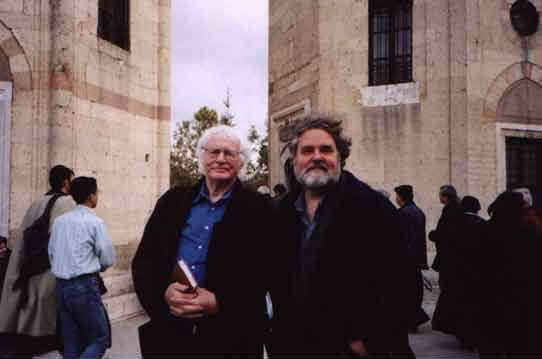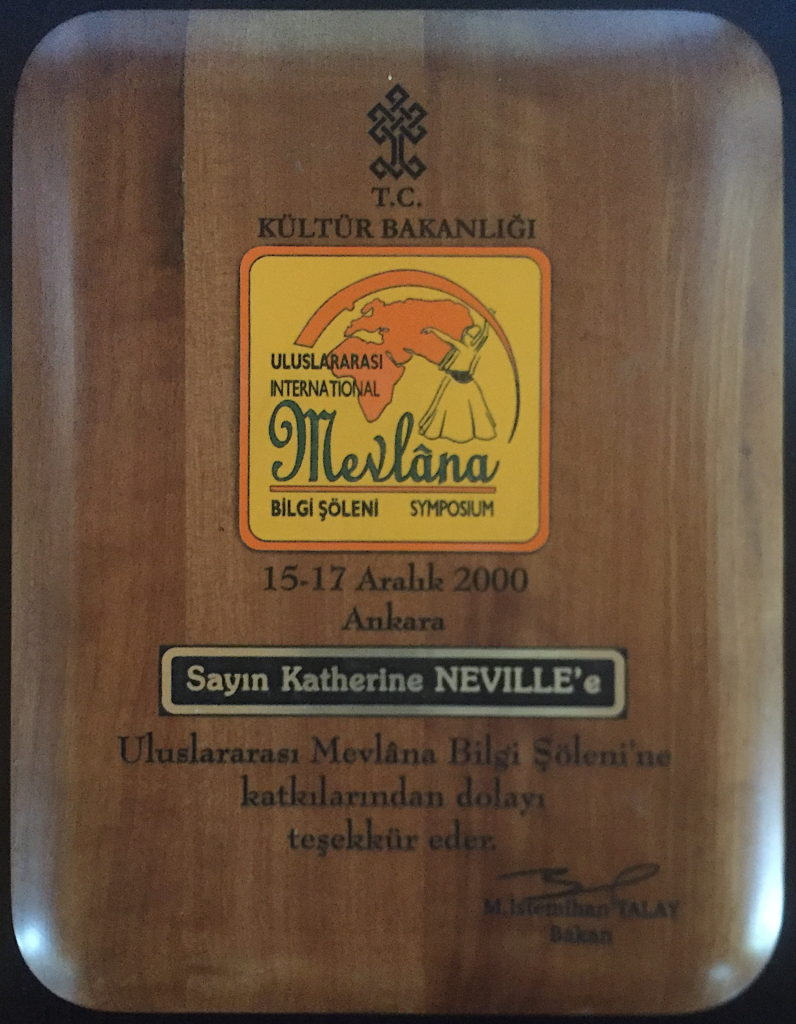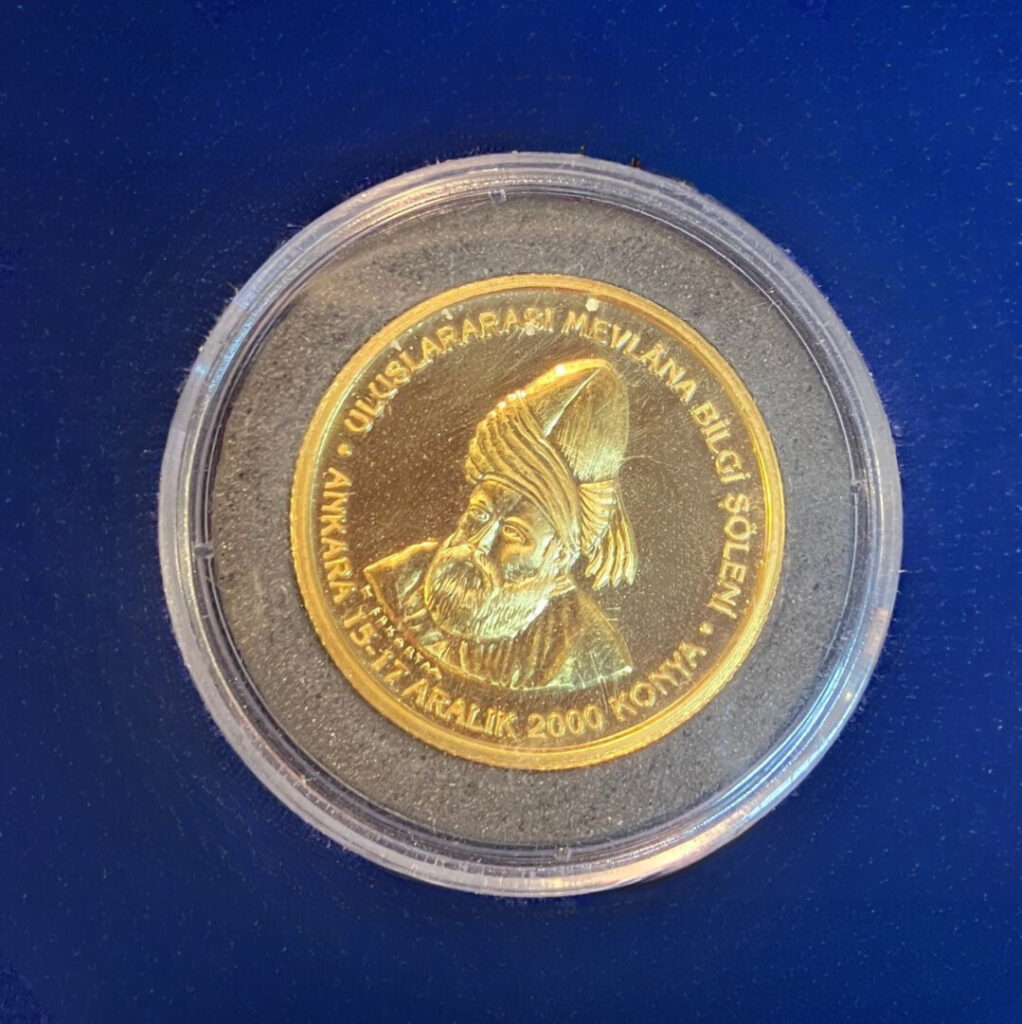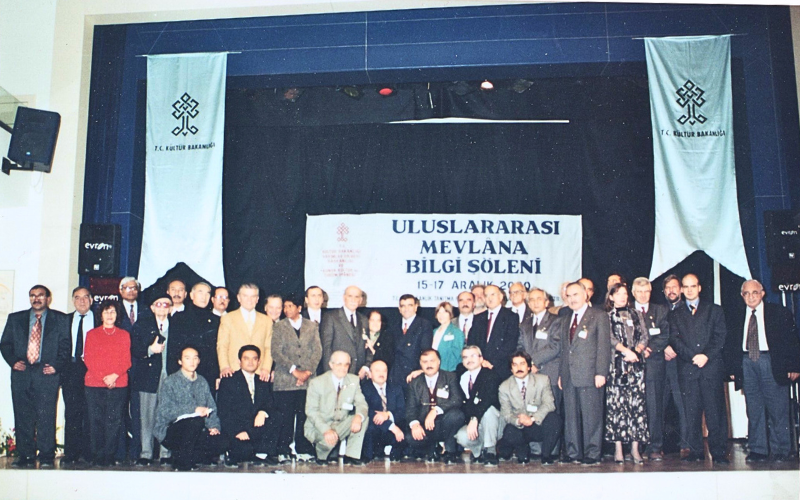December 2000 marked an important historic event in Sufi annals: the first Mevlana Symposium was held in Turkey, to commemorate the 727th anniversary of the death of the great poet and mystic, Jalal al-Din Rumi (known throughout Turkey as Mevlana, not as Rumi), the founder of the Mevlevi Order (The Whirling Dervishes).
The congress took place at Ankara and Konya from December 15-17, 2000.
Of only seven ordained sheikhs of the Mevlevi Order, three were present at the congress and presented papers: Huseyin Peter Cunz of Switzerland, Mursel Derkse of the Netherlands, and Suleyman Wolf Bahn of Germany. Nevit Ergin, translator from Turkish into English of the 11-volume Divan of Rumi, attended, and so did several members of the Celebi family, direct descendants of Jalal al-Din Rumi who still engage intimately in the living tradition created by their ancestor.
Katherine was one of only three Americans who were invited to present a paper at the congress (with poets Robert Bly and Coleman Barks, who have translated some of Rumi’s works into English).
The first two days of the congress, held at the cultural center of Ankara, were brief presentations (10 minutes only) summarizing the papers to be published. The third day, December 17, on the actual anniversary of Mevlana’s death, the congress participants traveled to Konya in central Turkey and visited the tomb of Rumi, then that night they attended the Sema, which we call in the west the Dance of the Whirling Dervishes.
Today, Rumi is the most popular poet in America. The irony in this enormous popularity is that Rumi considered his own fame as a kind of poison. There has been much controversy within the Sufi community about the presentation of the Mevlevi (dervish) Order as a kind of touring folkloric dance group, rather than the true Sufi religious order it is, which has been thriving for centuries. The symposium speakers addressed many of these issues. (Papers are available in the published proceedings.)
Invited Symposium Speakers at the 1st Mevlana Conference
The participants in the Mevlana Symposium included: Dr. Nevit O. Ergin, author of the 11-volume translation of the “Divan-i Kebir of Mevlana Celaleddin Rumi” published by the Turkish Republic Ministry of Culture; two members of the Celebi family, direct descendants of Rumi; Katherine Neville; Sheikh Mursel Derske of Holland; Robert Bly and Coleman Barks; Feyzi Halici, President of Konya Culture and Tourism Association; M. Istemhan Talay, Turkish Minister of Culture; Feyzi Halici (under the tree of life insignia); Dr Anna Masala of the University of Rome; Emrehan Halici of the Turkish senate and Vice President of FIDE, the World Chess Federation.
Katherine’s speech to the congress, due to the time constraints imposed on oral presentations, was very different from her published paper. The speech is reproduced, in summary, here for the first time.
Speech at the Mevlana Conference
I listened with enormous interest to this morning’s presentations. I was especially attuned to the presentation by Professor Cunz, who spoke about the Still Point of the Turning World, the connections between East and West.
The paper I submitted for the proceedings publication speaks a great deal about such connections, and how they relate to what we might call a kind of alchemy in the Sufi path. However, in the limited time we have for our speeches today, it is impossible to summarize it, it is very detailed: I will simply say that it is about the story of Joseph in Egypt, which appears in different versions in the Bible and the Qur’an, a story which was filled with meaning for Mevlana. Those who are interested may read it when the proceedings are published.
This morning, I would prefer to talk a little about the Sufi path and what it means to us today, here and now.
As everyone here already knows, but I emphasize, Sufi is a process, it is not a thing—it is not a noun, it is a verb, an active verb. You cannot walk into some store front, take a course of study with a bunch of tests, then someone gives you a piece of paper, and suddenly, you ARE a Sufi. And then you hang out a sign in front announcing you are a Master and you are taking on disciples to become your followers.
No, if you are on the Sufi path, YOU are the follower, and what you are following is a way of life, what you are doing is following a certain way of engaging with the world. And as everyone here also understands, in order to follow this path I’ve just mentioned, you MUST engage with the world—not just go off to some mountain top and sit around praying that the world will get better. It’s a process, an active process—and, in my opinion, it is a highly interactive alchemical process. It’s alchemy. The earliest alchemists were Sufi, and most of the alchemical works were written by Sufi mathematicians and scientists. But in alchemy, as in any process of value, before you can start turning someone else’s worthless pile of rock into gold, you have to start with yourself. The thing you need to be Master of is yourself.
My own studies in Sufi go back to the early 1970s, more than 30 years ago. But my training has principally been in the Shadhili path of North Africa. I knew very little about Mevlana—in America we call him Rumi—until seven years ago, when I was invited by (Konya’s Culture Minister) Feyzi Halici and his daughter-in-law, my friend Professor Ugur Halici, to come to Konya and attend the Sema (the dance, which is held in public each year on December 17, the anniversary of Mevlana’s death.)
When we headed on the bus up to Konya, Feyzi Halici asked why was I interested in seeing the Sema, I said, Because dance is the oldest form of prayer, and the circle dance is the oldest form of dance—all early people did it, even animals dance the circle dance, bees and elephants do it. It is our connection with the universe.
And, as we find with all esoteric or mystical processes, the right-hand turn, the clockwise turn represents the journey into the world, the adventure, the mythic discovery, the quest. But the left-hand turn, counter-clockwise, as it is in the Sema, is the quest for the soul, the self, the journey to inner vision, to the heart, to the truth.
The moment I saw the Sema unfolding that first night, at the very first steps of the dance, I knew that what we were seeing was the alchemical process unfolding—the Alchemical Marriage, as they call it, the marriage between heaven and earth. Everything was connected, even from the white robes and the reddish hat: the red symbolizing the spirit, the blood, the male, the father; the white is the body, the mother, matter—mater in Latin.
And the hands, one reaching toward heaven, the father, the spirit, the other reaching toward earth, the mother, the material world. The dancer is the axis, the pole, the Qutb, connecting the two with his own body.
And the end of the dance, with all the rainbow colored lights pouring over the dancers—in alchemy, we call this phase of the process the Peacock’s Tail—this is the final transformation where truth is found, the Alchemical Marriage, the Shebi Arus—the wedding night, as Mevlana called his final transformation—and as it is celebrated in the dance.
I have spoken a lot about these connections also in my paper on Joseph and Egypt, the country where alchemy was born. But, before ending my talk today, Karl Pribram made me promise that I would say how these connections affect us today. How are these symbols, archetypal images, and ages-old traditions still living for all of us today, and what do they mean to the world?
As Professor Peter Cunz pointed out in his presentation this morning, Turkey has always been regarded by the rest of the world as the connection (Qutb) between the Orient and Occident, the East and West, connecting two very different cultures—very much in the way the alchemical marriage takes place.
I should add that there is another country, today, that likewise connects East and West—my own country, the United States of America, which lies between two oceans, the Pacific which connects us to the Orient, and the Atlantic which connects us to Western Europe.
To illustrate that these two countries understand, at a very deep level, the role they must play in the future of the world, all we need to do is look at the flags they have chosen to design to represent themselves.
The Turkish flag is grounded in a field of red: the blood, the spirit, the male, the father. In white, we have a crescent moon and a five-pointed star, both representing the mother, the female, the material world. In America, our flag has red and white stripes, representing the marriage of spirit and matter, father and mother. We also have a square of midnight blue, filled with five-pointed stars, both representing Stella Mare, Queen of the Sea, the Mother who represents both the terrestrial sea and the sea of the heavens. A connection of seas, not only of east and west, also above and below.
Because both these countries represent the connection of East and West, spirit and matter, we are both like dancers, at the “Still Point of the Turning World.” From the Sufi perspective, our path requires action. America must find a way to infuse Spirit into our material life, to connect as much with the East as we do with the West. And Turkey must move to connect, in a material way with the West—Material means grounding in matter, economic grounding with the West, as in joining with the European Union. The message that is in our flags is in our futures.



